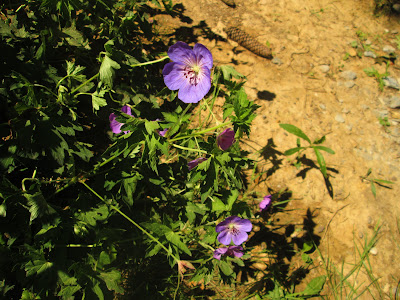As any gardener knows, any new (and maybe just any) garden is likely to be plagued with weeds, and when that garden is in a public place and maintained by volunteers, this could be a problem. When the butterfly garden in front of Harmar Village's historic railroad cars was being created, a generous donor supplied heavy landscape fabric for the entire site, and a volunteer team installed it. When the site was planted, other volunteers cut holes in the fabric and tucked in our baby landscape plugs. It was a good day.
For the most part, the fabric did its job. This spring's weeding team found no dandelions or bermuda grass, and with regular rains most of the plants thrived, with the exception of a few too close to a thirsty-rooted tree. But--we did discover a problem.
The lovely dark organic mulch used to cover the landscape fabric created a perfect home for Glecoma hederacea, AKA ground ivy or creeping Charlie. We removed at least one wheelbarrow load of that particular unwanted vine and made the decision to remove the landscape fabric as well.
Rather distressing was the discovery that the several dozen monardas on the site had completely failed to root into the soil. As we slashed and lifted the fabric from the site, entire monarda plants came with it, their root systems spreading through the mulch above the fabric but no feeder roots developing in the native soil.
This could have developed into a serious problem, but with all plants now rooted in actual dirt, the site's bee balm patch seems to be doing fine.
We have since learned that landscape fabric does best with inorganic mulches like stone, so it has been banished from our pollinator-friendly space.













